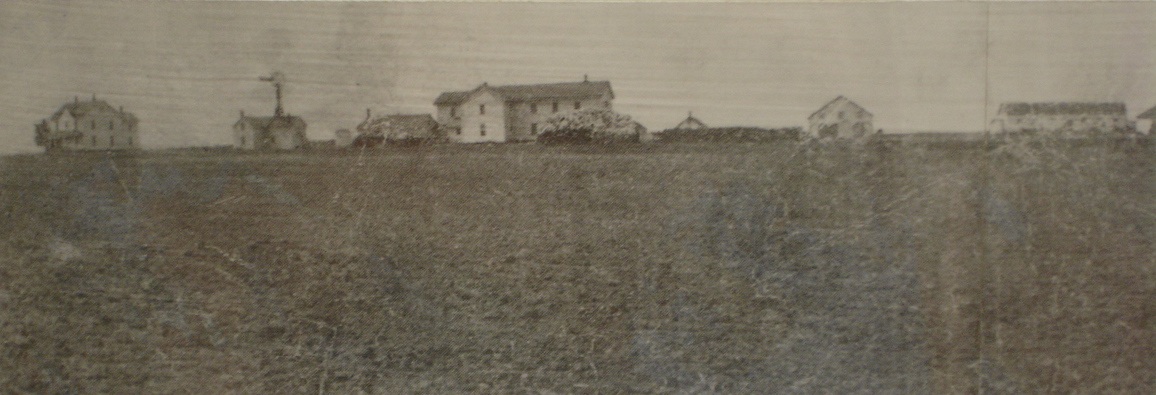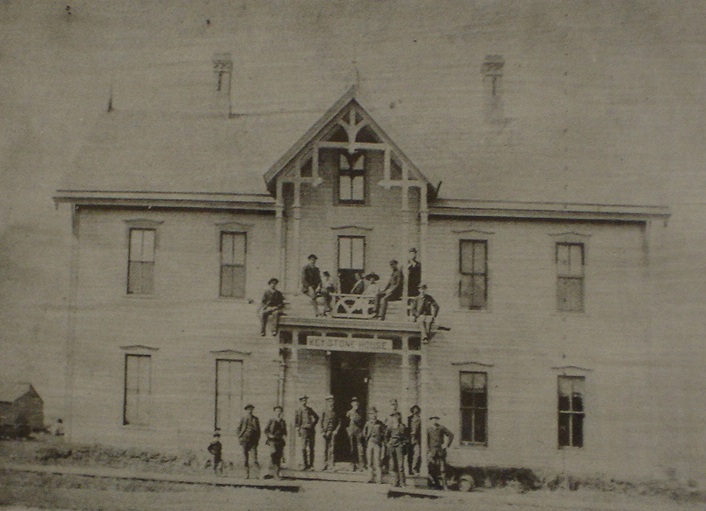Page 425. KEYSTONE township, also organized in 1881, had the very large Keystone farm, owned by capitalists in Pittsburgh, Pa. This farm was named for Pennsylvania, the “Keystone State,” which was at the center
Page 426. in the series of the thirteen original states, like the keystone of an arch. (Minnesota Geographic Names, Their Origin and Historic Significance, Warren Upham, Minnesota Historical Society, Saint Paul, Minnesota, 1920)
EUCLID township, organized in 1879, and its railway village, were named by Springer Harbaugh, manager of the large Lockhart farm in Norman county, for the beautiful Euclid avenue in Cleveland, Ohio, where he had formerly lived. (Minnesota Geographic Names, Their Origin and Historic Significance, Warren Upham, Minnesota Historical Society, Saint Paul, Minnesota, 1920, Page 424)
The Wheat in Minnesota. St. Paul, Minn., Aug. 27. – Springer Harbaugh, one of the largest farmers in Northern Minnesota, has just returned from a trip through the northern counties. He says that wheat harvesting is about two-thirds completed. The appearance of the grain was very good, but upon a critical examination it was noticeable that there was a deficiency in the filling out of the heads, as compared with the crop of previous years. This was particularly the case with wheat. He was of the opinion that the wheat had run too much to straw, and that while in bloom the heavy rains and storms had washed off the pollen, which makes each kernel fill out well. The extreme heat which followed the storms hastened the ripening, and while the heads look ripe the kernels are still unmatured. No particular damage had been done by the frosts except to late sown wheat and vegetables. The quality of the grain, he thought, would not be equal to last year’s yield, and much of the crop would be what is known as “red dog” and “stump tail” wheat. The larger quantity of the wheat in that section this year would fall much below what it graded in previous years. (The New York Times, Friday, August 28, 1885)
With the rapid movement of railroad building into the northern part of the valley, the opening of large farms continued unabated. By 1885 nearly all of the original large farms had been established. The J. J. Hill farm of nearly a township, in Kittson county, is probably the nearest to the International boundary. The Reid farm in the same county is another in point. In Polk county the Buffington and Key Stone farms are representative; in Norman, the Lockhart farm [,] in Grand Forks [county] the Elk Valley, Emery and McCanna farms, etc. The census of 1890 show 323 farms which exceeded 1,000 acres in area while those which exceeded 500 acres were 1,253 in number. The first group represent farms of two sections or more, the latter group those of four, five or six quarter sections. (Collections of the State Historical Society of North Dakota, Volume III, Tribune, State Printers and Binders, 1910, Page 581)
The following interesting facts are culled from a letter furnished to the survey by Mr. Springer Harbaugh, published in the thirteenth annual report. Mr. Springer Harbaugh, os St. Paul, 1885, says: “At Keystone farms in T. 151-48, since 1881 we have drilled eight artesian wells and they all have regular continuous flows of pure, good and semi-soft water.” (The Geology of Minnesota, 1896-1898, Volume IV, N. H. Winchell, The Pioneer Press Co., Printers, St. Paul, Minnesota, 1899, Page 112)
Page 252. The next day we took the train for Euclid, to visit the great “Keystone” farm. Fortunately for my purpose, the manager was away for the day and we were forced to make all our inquiries from the men. For the absent manager I conceived a high regard. His was just such a farm as has been glowingly described in so many magazine articles lauding the new order of farming. There was a splendid array of farm buildings, freshly painted in white and red, and everything about the place indicated perfect equipment and perfect management. We reached it just at noon, when, at the tap of a bell, sixteen hands filed out of the “men’s parlour,” went to the stable, and presently emerged with five fine Norman horses each, which they took to the fields. One man with five horses and a gang-plough, I was told, could cover five acres in a day, or as much as two men with three horses apiece could cover with the ordinary single plough. Right here, then, was one of the vaunted economies of the new order: one man with five horses and a $75 plough was doing as much as two men with six horses and a cheap plough. But here again closer questioning showed the common sense of the independent farmers, who for most fields preferred the single plough. The gang-plough did not do its work quite as well, and if the difference was only a bushel an acre there was a loss. The farmer who hired labour to cover immense areas preferred the gang-plough, but the farmer who did his own work on a small farm could
Page 253. well afford to give a few days more to his ploughing and get a larger yield. Another economy also for the small farm forced itself on my attention. The small farmer was always within a few minutes of his work. The hands on the ten-square-mile farm often had to walk a mile or two four times a day to reach theirs.
By this time, however, I was more interested in the life of the workmen than in the economic problems I came to investigate. Professor Hoverstad [from the Crookston agricultural experiment station] and I were asked to the table, which the men had just left, and had an excellent dinner. My own observation, therefore, did not confirm what I elsewhere had heard about the inhuman treatment of hands on the great farms. After dinner we sat down in the “men’s parlour” and talked to our heart’s content with a group of three or four men who were “pressing hay,” as they termed it. They were all on sick leave, but their wages, they said, were docked “just the same.” The attitude, however, was just the opposite of grumbling. After the fashion of men who do not entirely take you into their confidence, they were inclined to put the best face on things. They preferred, one or two of them said, to belong to the crew on a big farm to being the only hand on a small one. When I asked whether the small farmer didn’t treat them as one of the family and share with them everything the family had, the answer was: “Yes, but the work is never done. There are so many more chores.” Here they had a “ten-hour day.” Afterwards, when they told about their day, their
Page 254. reckoning of hours seemed quite liberal to their employer. On week-day mornings they got up at four o’clock; on Sundays, except in threshing-time, they got up at five. During threshing-time they worked on Sundays the same as other days and got “thresher’s wages” – $1.75 a day – instead of their regular $20 a month. Before breakfast they had to look after their five horses. They were due in the fields at six, and from that hour they dated their day’s work. They worked from six till eleven, when they started back to the barns. After dinner they were not called out again until 12:45, because the “horses have to have an hour to eat.” They then worked till six. It generally took them nearly half an hour to bring their horses in, and nearly an hour to feed and bed them. By the time they had finished with the horses and had had their suppers it was often 8:30. To get up the next morning at four, most of them wanted to go to bed. Those who sat up awhile could talk or play checkers. No cards were allowed, and no liquor.
These last rules seemed to be rigidly enforced, and with the general consent of the men. In spite of this enforced morality, however, the life seemed demoralizing. The men were utterly cut off from family life, and from higher life of any form. They received a remarkable opportunity to lay up wages, but a more remarkable opportunity to “blow them off” when they reached the city at the end of the season. Most of them went to the logging-camps for the winter, and
Page 255. the garrulous Irishman, who was the best talker in the group, assured us that the life there was even finer than on the big farm. “The food is good, the lodging just about as good as here [where they slept eighteen in a room]; the days are shorter, and we have cards at night.” If David A. Wells’s dream of the big farm driving the small farm to the wall were in danger of being realized, the future of Minnesota would look as dark as it now looks bright.
But the dream, or nightmare, is in no danger of being realized. Even this well-managed farm was not believed by the men to be profitable. Their evidence, it is true, was of little value, but there were many things to indicate heavy expenses which the small farmer’s family saves him. At the time of my visit there were just forty people employed on these ten sections, where just as many families might have cultivated independent farms of the typical Minnesota size. Of these forty, one was superintendent, one was foreman, one was stable-boss, one was dairy boss, one was gardener, one was blacksmith and mender, four were gardener’s helpers, two were dairy helpers, four were stable-boys, three were women, and one was called “flunkey” by the aristocrats of the “men’s parlour.” Thus twenty out of the forty were either doing the work of supervision which the independent farmer does for himself, or else were doing the work in dairy and kitchen and garden and stable which the independent farmer’s wife and children do for him. (America’s Working People, Charles B. Spahr, Longmans, Green, and Co., New York, London, and Bombay, 1900)
But in Keystone township, which bounds Tabor on the south, there were no foreign born Bohemians in 1905. We might also note that the population of Keystone township, which is the headquarters for the bonanza “Keystone farm,” was 224, while that of Tabor township was 481. (Collections of the State Historical Society of North Dakota, Volume III, Tribune, State Printers and Binders, 1910, Page 643)
BUYS A BIG FARM. Kenneth Clark of St. Paul Gets Nearly 10,000 Acres. Special to The Globe. CROOKSTON, Minn., March 24. – The largest real estate deal ever consummated in Northern Minnesota and perhaps the largest in acre property ever closed in the state was made last Saturday, when Kenneth Clark, president of the Merchants’ National bank of St. Paul, purchased of Charles Lockhart, of Pittsburg, Pa., through Frank O’Meara, of St. Paul, the famous Keystone farm in Polk county, the consideration being $208,520, and the number of acres involved being 9,104. The land lies in a solid block in township 151 and 152, range 48, and is one of the largest farms in the northwest. The land was acquired by Charles Lockhart many years ago and a large percentage of the property is under cultivation, a good sized area being employed as a range for cattle, while there are some portions thickly covered with good timber. The property has always been considered valuable and a source of profit to its owner, who is advanced in years and is consolidating his landed interests. (The Saint Paul Globe, Wednesday Morning, March 25, 1903, Volume XXVI, Number 84, Page 3)




